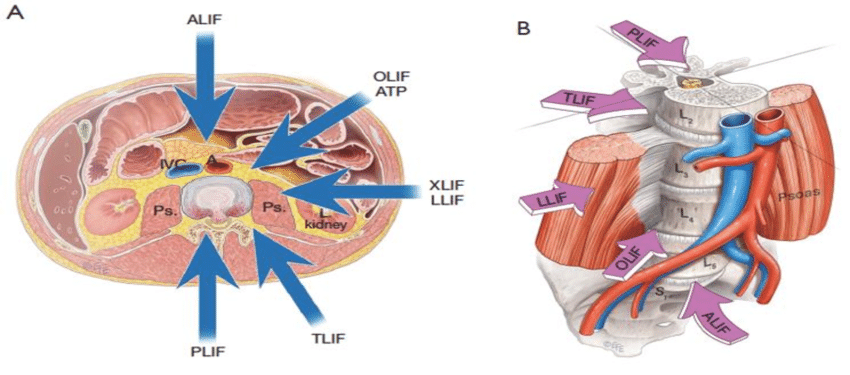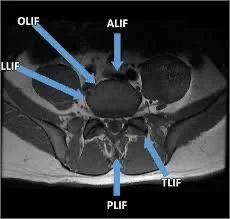Understanding Lumbar Fusion: Five Approaches for Interbody (Spacer) Placement
If you’ve been recommended a lumbar fusion for back pain, scoliosis, disc degeneration, or spinal instability, it’s natural to feel a little nervous. Many patients worry that fusion means they’ll lose mobility or won’t be able to return to the activities they love.
💡 The truth: fusion can be life-changing when it’s the right surgery for the right patient. It can restore stability, improve pain control, and give you back your quality of life. Patients can still touch their toes (if they could before surgery), swing a golf club, and enjoy sports or the gym.
Let’s break it down step by step.
🔹 What Is Lumbar Fusion?
A fusion joins two vertebrae together so they act as one solid bone. This is done using an interbody device (a cage or spacer) that is filled with bone graft.
The spacer is usually made of titanium or titanium-coated PEEK (a strong plastic).
The bone graft can come from your own body, a donor (cadaver), or synthetic options.
Over time, the bones above and below grow through the spacer, creating one solid structure.
✅ Goals of fusion:
Restore spinal stability
Correct alignment
Reduce or eliminate pain
🔹 The Five Main Approaches to Lumbar Fusion
There are five primary surgical approaches to place the interbody spacer. Each has its own advantages and considerations, and your surgeon will choose the one that best fits your condition and anatomy.
1️⃣ Anterior Lumbar Interbody Fusion (ALIF)
Access: through the front of the abdomen (with the help of a vascular or general surgeon).
Advantages:
Allows placement of a larger cage → more stability.
Avoids back muscles, which may reduce post-op back pain.
Excellent for lower lumbar levels (L4–L5, L5–S1).
Considerations:
Requires a vascular or general surgeon for access (not available at all hospitals).
Small risk of vascular injury (major blood vessels nearby).
May cause temporary abdominal discomfort.
Not ideal for higher levels (aorta is in the way).
2️⃣ Lateral Lumbar Interbody Fusion (LLIF / XLIF)
Access: from the side of the abdomen (through the flank).
Advantages:
Places a large interbody device for better support.
Spares back muscles.
Considerations:
Limited to certain levels (L2–L5).
Not suitable for L5–S1 (hips are in the way).
Risk of irritation to lumbar plexus nerves (controls hip flexion).
3️⃣ Oblique Lumbar Interbody Fusion (OLIF)
Access: from a slightly forward/angled side approach.
Advantages:
Avoids major blood vessels and the psoas muscle.
Can access L5–S1 (unlike LLIF).
Minimally invasive, quicker recovery.
Considerations:
Requires specialized training and expertise.
Still carries small risks of vascular or bowel injury.
4️⃣ Posterior Lumbar Interbody Fusion (PLIF)
Access: from the back of the spine.
Advantages:
Direct access to spinal nerves and canal.
Can treat stenosis and do decompression at the same time.
Works at all lumbar levels.
Screws and rods often placed during the same surgery.
Considerations:
Involves cutting through back muscles → more pain, longer recovery.
Higher risk of spinal fluid leak.
Interbody device is smaller because nerves must be moved aside.
5️⃣ Transforaminal Lumbar Interbody Fusion (TLIF)
Access: from the back, but slightly to one side.
Advantages:
Can be performed at any lumbar level.
Allows direct decompression of nerves.
Usually less bone removal than PLIF.
Considerations:
Interbody device is smaller than in ALIF, LLIF, or OLIF.
🔹 Dr. Katsevman’s Approach
Whenever possible, Dr. Katsevman prefers ALIF or LLIF approaches, as they:
Place the largest interbodies → better stability and fusion.
Avoid disrupting back muscles.
If screws are needed for additional support, they can still be placed through a separate minimally invasive incision, often with minimal muscle disruption and no bone removal.
✅ The Bottom Line: Fusion Isn’t the Enemy
While newer motion-preserving options like disc replacements and the TOPS device are excellent for certain patients, fusion remains the gold standard for many conditions.
👉 And here’s what patients often don’t realize:
Fusion does not mean you’ll lose all motion.
Many patients still bend, twist, golf, play pickleball, and exercise freely.
Fusion can give you back stability, reduce pain, and restore mobility.
No miracles — if you couldn’t touch your toes before surgery, you won’t afterward. But for many patients, fusion drastically improves quality of life.
Questions?
Naples Office: (239) 649-1662
Fort Myers Office: (239) 437-1121
or click the “Contact” tab above to get scheduled.


